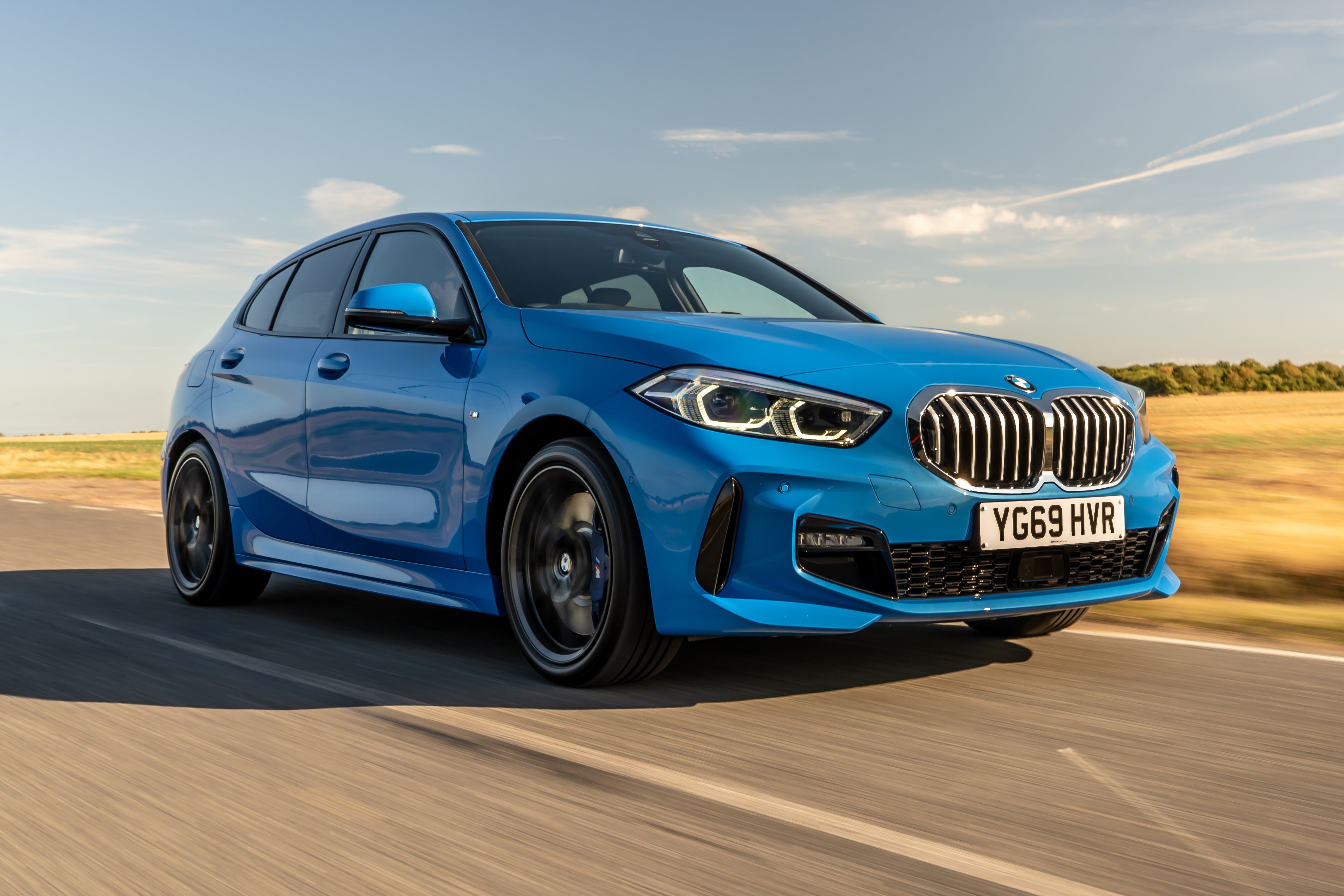BMW 1 Series (2019-2023) Review
Written by Andrew Brady
Quick overview
Pros
- Great to drive with strong engine line-up
- Interior is practical and hard to fault
- 128ti is a really good hot hatchback
Cons
- Ride a touch firm on sportier trims
- Looks won’t appeal to everyone
- More expensive than a Volkswagen Golf
Overall verdict on the BMW 1 Series
"The latest BMW 1 Series might be, erm, challenging to look at and no longer rear-wheel drive, but it has plenty to recommend it. We reckon it's got the best interior of any hatchback and the driving experience still stacks up very well. "

Traditionalists look away: for the third-generation 1 Series, BMW has ditched the traditional rear-wheel-drive layout. The benefit is much more passenger space, while the driving experience hasn't suffered - if anything it's better to drive than the old car. But is it the best hatchback you can buy? Read our 2024 BMW 1 Series review to find out.
There is a wide range of engines on offer with the BMW 1 Series, from economical three-cylinder diesels to the Porsche-baiting M135i hot hatch. Unless you cover mega miles, we’d highly recommend the entry-level 118i. This is a punchy little three-cylinder 1.5-litre petrol engine, which is both efficient and makes the car fun to drive, while the 118i is relatively affordable for a premium hatchback.
The diesel engine of choice is the 2.0-litre 118d, while the more powerful 120d is available with xDrive four-wheel-drive. Most buyers won’t need this, but it’s there as an option. In 2021 BMW also added a VW Golf GTI-baiting model called the BMW 128ti. It's not four-wheel-drive like the faster M135i, but in many ways it's actually more fun and engaging to drive, while being cheaper, too.
While we love how good any version of BMW 1 Series is to drive thanks to its precise steering and compliant (if a little firm) suspension, it's most impressive feature is its cabin. It’s on a par with - if not better than - the latest Mercedes-Benz A-Class and Audi A3. It uses very good quality materials, has an intuitive control system and there’s more space than ever before, particularly for front-seat passengers.
The BMW 1 Series has a big enough boot for most buyers and the rear seats are easily dropped if you need more space. ISOFIX points in the rear make fitting child seats easy, and the five-star Euro NCAP safety rating should put your mind at ease when it comes to transporting your family in the BMW 1 Series.
Standard equipment is pretty good on the BMW 1 Series, meaning you won’t have to go hunting for used examples fitted with any must-have options. Initially, all regular models came with a very good 8.8-inch media system incorporating all the usual features such as navigation and Apple CarPlay (for mirroring apps from your phone). Android Auto wasn't provided initially, but was added later. A bigger 10.25-inch display was available as an option (standard on the M135i and 128ti), and this incorporates BMW’s Siri-like Intelligent Personal Assistant, which responds to voice commands and learns your preferences over time. This upgraded system was later made standard across the range.
So what hasn’t the new BMW 1 Series got going for it? Well, we’re not so sure about its looks, due to that gaping front grille and the slightly stodgy dimensions. It’s just not as timeless as the old model, but you can decide for yourself whether you like it or not.
The BMW 1 Series is also pretty expensive, a fair bit more than a Volkswagen Golf, for example. It’s also in high demand, meaning you’ll pay strong money for a used example.
If you’re happy to pay the price for the BMW 1 Series, the latest model is easier than ever to justify. It’s more practical than before and has a superb interior that puts it in the same league as the Mercedes-Benz A-Class. It’s also brilliant to drive no matter which engine you opt for. Indeed, the entry-level 118i is arguably the most appealing all-rounder of the bunch.
Looking for a used car for sale? We've got 100s of BMW Approved Used Cars for Sale for you to choose from, including a wide range of BMW 1 Series models for sale. If you're looking for the newer version, you need our BMW 1 Series review, while you might also be interested in our previous generation BMW 1 Series (2011-2019) review.
Is the BMW 1 Series right for you?
If you want a smallish family car with a premium interior that’s more enjoyable to drive than a Mercedes-Benz A-Class or Audi A3, then the BMW 1 Series is a strong choice. There’s a wide variety of petrol and diesel engines, including the hot 128ti and M135i models for those looking for sports car performance without practicality compromises.
There are some caveats. While its interior is better (and more practical) than ever, it's still a fairly cramped family car. If you’re looking for something with a big boot and more rear seat space, you’d be better putting your badge snobbery to one side and looking at a Skoda Octavia.
It’s also expensive compared to mainstream alternatives. Sure, a Kia Ceed or Ford Focus might not be on your radar, but a Volkswagen Golf is very nearly as good as the BMW 1 Series and can be had for less money. It's not as nice inside, however, nor is the technology as easy to operate.
What other cars are similar to the BMW 1 Series?
Before parting with your cash for a BMW 1 Series, you should also look at the Audi A3 and Mercedes-Benz A-Class. All three are competing for class honours, and there’s little to differentiate between them, really. We reckon the A-Class’s interior perhaps pips the BMW’s for wow-factor and you get slightly more standard equipment on the A3, but there’s not a great deal in it objectively.
If getting more for your money appeals, you should also consider the Volkswagen Golf. It’s not got a premium badge but it’s certainly a step up from cars like the Ford Focus and Vauxhall Astra.
Comfort and design: BMW 1 Series interior
"The BMW 1 Series might be the firm’s entry-level car, but there’s little to distinguish it inside from bigger and more expensive models. Indeed, its cabin looks very similar to that of the latest 3 Series, with angular air vents, a strip of buttons for the climate controls and a beefy steering wheel."
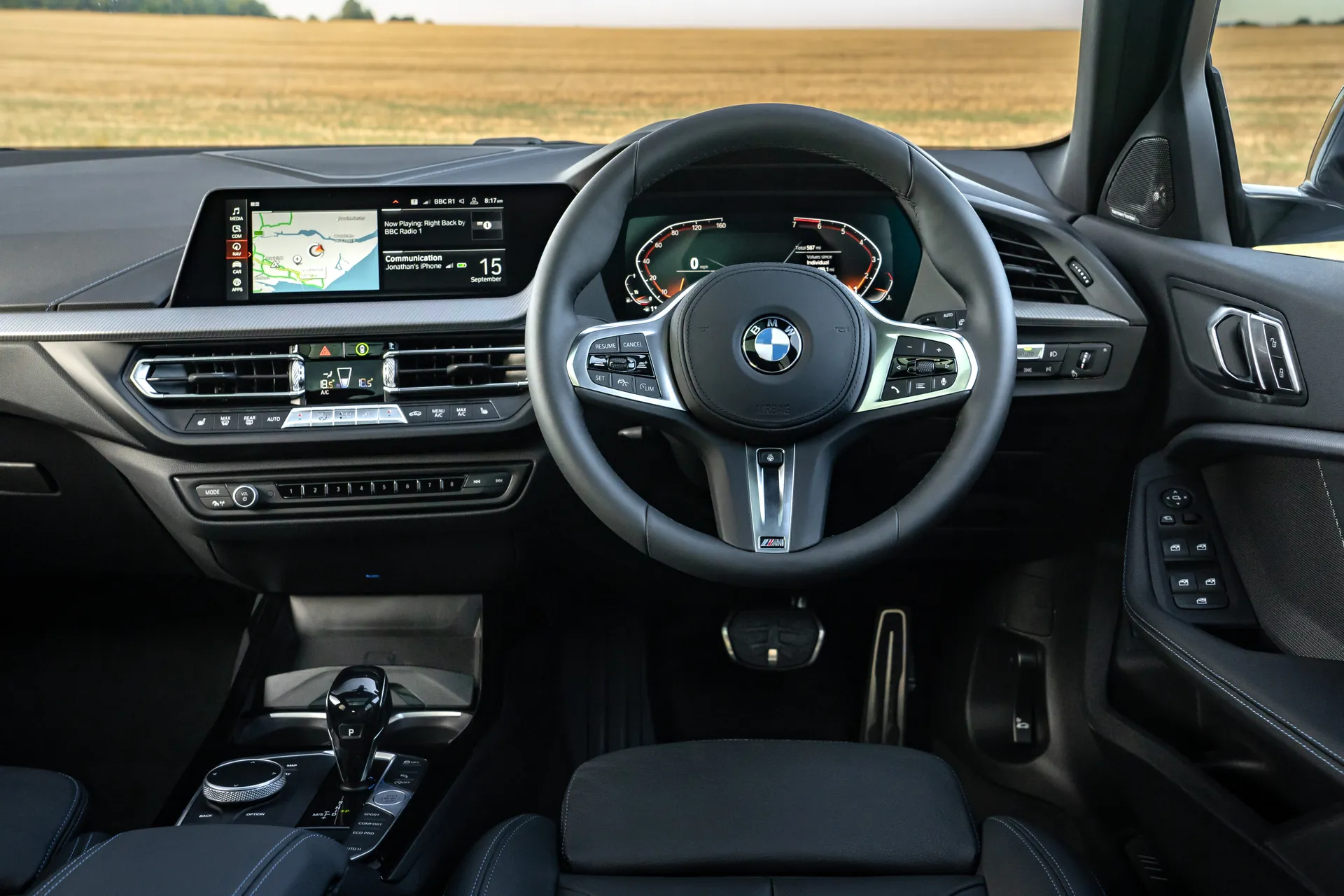
The BMW 1 Series is a five-star car in terms of driver comfort, with plenty of adjustment in the seat and steering wheel ensuring you’ll find a suitable driving position very easily. It’s a bit disappointing that electric seat adjustment and lumbar support are both optional extras when new, but that’s par for the course in cars of this size.
For most drivers the lack of electric seat adjustment is not an issue: you’ll set it up once and rarely have to make adjustments ever again. It becomes more of a problem if you’re sharing the car with other people.
If you’re lucky, you might find a BMW 1 Series with one of the optional comfort packs fitted. Comfort Pack 1 includes heated front seats, extended lighting, folding door mirrors and a luggage compartment package, while the Comfort Pack 2 adds steering wheel heating, an automatic tailgate, comfort access (with a digital key using your phone) and electric seat adjustment.
The standard BMW 1 Series SE comes with generic cloth seats, which are comfortable enough but look a bit drab, frankly. The rest of the range comes with front sports seats which look much better and provide lots of support, while the M135i has more focussed M Sport seats with chunky side bolsters and integrated headrests.
Overall, BMW has managed to nail the combination of quality, design and user-friendliness better than rivals. In fact, we'd go as far as saying that you won't find a nicer interior in a hatchback.
Quality and finish
You won’t have any qualms with the interior quality of the BMW 1 Series. It feels super-premium, with soft-touch materials and shiny metal trims aplenty. All the knobs and buttons have a satisfyingly solid feel to them, while even the indicator stalk feels like it’ll last forever. Insert a joke about BMW drivers here.
Sure, it might not have the instant design wow-factor of the Mercedes-Benz A-Class (there’s no ambient lighting here), but the more time you spend in the BMW's cabin you realise that it's actually more solidly put together out of nicer materials. It's also considerably more plush than the cabin of the Audi A3.
We’ve mentioned the drab cloth seats of the entry-level SE model, but BMW 1 Series Sport models feature a number of extra features to make the cabin feel a smidgen more special. These include extra contrast stitching, Sensatec (fake leather) seats and the illuminated ‘Berlin’ interior trim. We’d recommend looking for a Sport model for these alone, otherwise you might as well be driving a Ford Focus.
Infotainment: Touchscreen, USB, nav and stereo in the BMW 1 Series
Most early BMW 1 Series models came with BMW’s Live Cockpit Plus, which uses an 8.8-inch display that can be controlled via touchscreen or the BMW iDrive rotary controller on the centre console. It’s a brilliant system: easy to navigate and fast to respond with sharp, bright graphics. The navigation works well, providing clear and logical directions and, well, performing exactly as you’d expect for a nav system in a premium car.
There was also a larger 10.25-inch display (called the Live Cockpit Professional), which was standard on the BMW 1 Series M135i and 128ti, and offered as a desirable option on lesser models. This would have cost £1000 when new or would have been part of the £1500 Tech Pack 2, which also brought with it a fancy Harmon/Kardon sound system. Both of these features are worth looking out for on used models. Buy a younger example, though, and you'll definitely get the upgraded system, because it was later made standard across the range.
The bigger screen also brings with it BMW’s Intelligent Personal Assistant. This is a Siri- or Alexa-like system. You activate it by saying ‘Hey BMW’, and it learns your preferences over time.
When the third-generation BMW 1 Series was first launched in 2019, BMW had the daft idea that it would charge owners an annual subscription fee for Apple CarPlay. Fortunately, after a lot of criticism (it’s free on a Kia Picanto…), it changed its mind. So, long story short, all BMW 1 Series models will have Apple CarPlay and you’ll be able to use it for free. Forever.
Android Auto was initially not available on the BMW 1 Series either as an option or as standard, as with other BMWs. But in 2020 it was added as standard on every model using the latest iDrive 7.0 system, so it could be installed retroactively on 2019 1 Series models.
Space and practicality: BMW 1 Series boot space
While the old BMW 1 Series was never a particularly practical choice, the latest model is significantly roomier inside, despite having much the same footprint as its predecessor. If you're interested, the new BMW 1 Series has dimensions of 4319mm in length, 1799mm in width and 1434mm in height.
The reason that the old car wasn't that practical was because it stuck with a rear-wheel-drive platform and longitudinal engines (hence the long bonnet): great for wannabe Lewis Hamiltons, not so great for families doing their weekly shop. The new model is more conventional in its approach, now being front-wheel drive, and you’ll notice how spacious it is as soon as you take a seat.
There’s loads of head-, leg- and elbow room in the front of the BMW 1 Series, along with plenty of stowage including large door bins and a usefully large cubby box under the central armrest.
Rear space is on a par with that of the Audi A3 and Mercedes-Benz A-Class, although that’s not saying much as none of these small premium cars feel particularly luxurious in the back. If you plan to regularly carry adults (or lanky teenagers) in the rear seats, you’d be better looking at a bigger BMW like the 3 Series or X3 SUV. Otherwise, anyone approaching six foot will touch the roof with their head and stick their knees into the front seats. It’ll be fine for short journeys when necessary, but it’s not massively comfortable for longer trips.
Of course, kids will be happier in the back, and there are ISOFIX child seat mounting points fitted to the outer rear seats. Access to these is pretty easy - especially as all 1 Series models now have five doors. You might want to consider a higher-riding crossover SUV like the X1 or X3 as an alternative, though: your back will appreciate not having to lean over as much to fit child seats.
The boot on the BMW 1 Series is about as big as you’d expect from a car of this size, capable of carrying 380 litres of luggage with the rear seats in use (drop them for up to 1200 litres).
That’s identical to the latest Audi A3 Sportback and Volkswagen Golf, and marginally bigger than the Mercedes-Benz A-Class’s 341-litre boot. Access is easy, with only a small lip, while an electric tailgate is available as a £500-plus option when ordering new. This is nice to have but wouldn’t be a deal-breaker, in our opinion - it’s not like the conventional boot lid is particularly difficult to open or close.
Handling and ride quality: What is the BMW 1 Series like to drive?
"The old BMW 1 Series was unusual in that it transferred power from the engine to the road via the rear wheels - rather than the fronts, like pretty much every other car of this size."
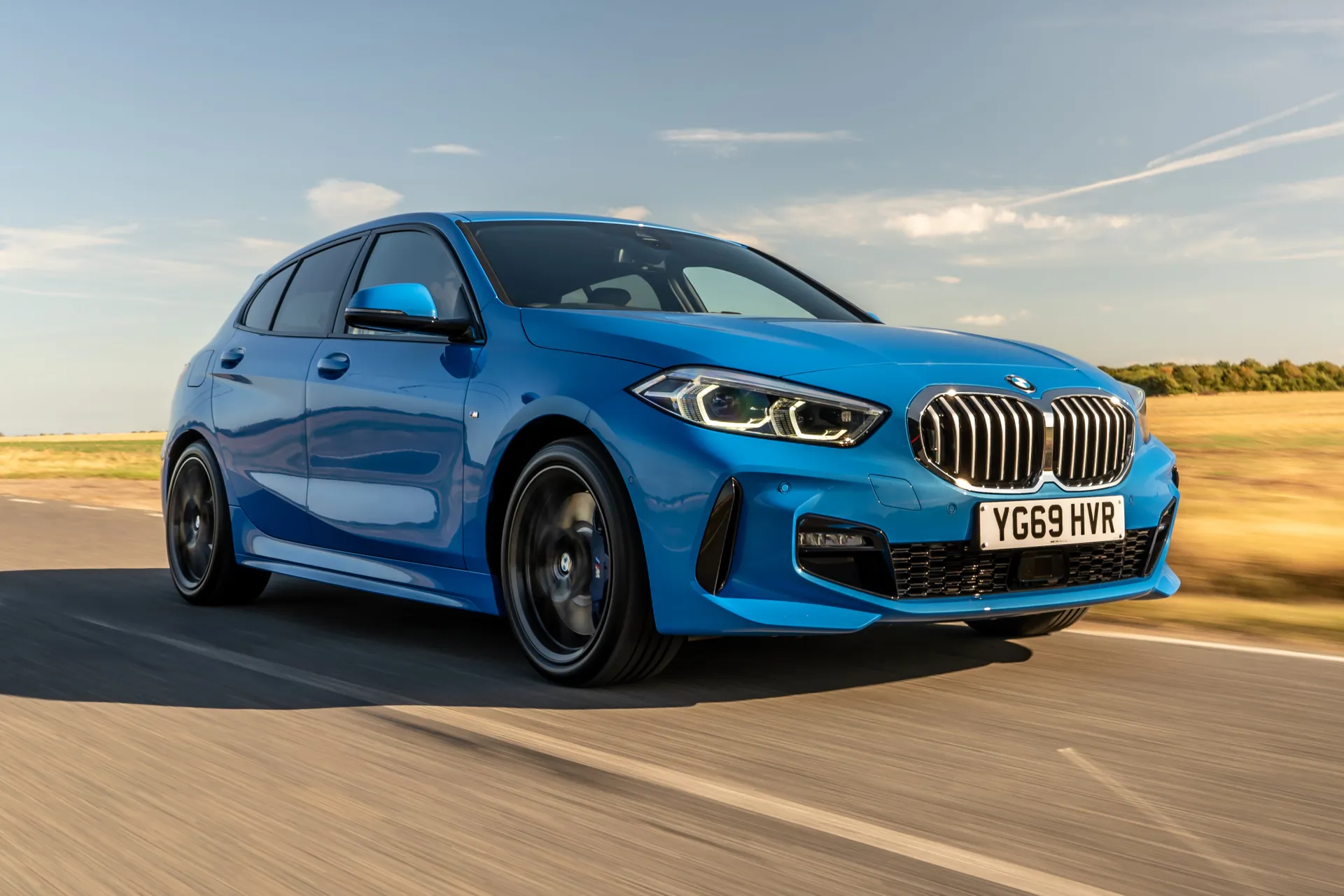
That meant it was supposedly better to drive, with the car pushed rather than pulled through bends and the front wheels left to prioritise the job of steering.
Driving enthusiasts would prefer it this way. But the majority of drivers of the old 1 Series didn’t know (or care) that they were driving a rear-wheel-drive car, so BMW finally gave up on that idea and the latest model is predominantly front-wheel drive.
There are numerous advantages to this more conventional layout, including lower running costs, safer all-weather handling and improved practicality). And yet, the BMW 1 Series is still the most enjoyable car in its class to drive. The steering is communicative, the brakes feel powerful and the suspension is both compliant and confidence-inspiring.
BMW 1 Series M Sport models come with firmer suspension and larger 18-inch alloy wheels as standard. That means you’ll know about it if you hit a pothole or take a speed bump at, er, speed. It’s not uncomfortably harsh, but we’d recommend looking for an SE or Sport model with their standard suspension set-up if you’re looking for ultimate comfort.
The sporty M135i uses BMW’s xDrive four-wheel-drive system to aid traction, while the 120d is also offered with xDrive. This costs an extra £1500 or so when new and will fetch a premium on the used market, too. It’s not worth paying extra for, in our opinion: the standard front-drive model offers perfectly safe handling and a set of winter tyres will make a bigger difference if you’re concerned about driving in the snow.
The M135i is very fast, grippy and composed, but there's not that much enjoyment to be had. Enter the BMW 128ti, which is lighter by virtue of only driving the front wheels, while it also has retuned, lower suspension. This makes it feel that bit more focused, sharp and engaging and while the ride is firmer, it's rarely uncomfortable. We're not talking Honda Civic Type R levels of excitement here, but the 128ti is more fun than the M135i while still being smartly designed and upmarket inside.
What engines and gearboxes are available in the BMW 1 Series?
The most affordable engine in the BMW 1 Series is the 1.5-litre three-cylinder turbocharged petrol, badged the 118i. It’s the same engine that’s used in numerous BMW and MINI models, and it’s brilliant, punching well above its weight in terms of performance while also returning decent fuel economy.
This is available with either a six-speed manual or seven-speed dual-clutch automatic gearbox. We rate the auto: it changes gears quickly and makes day-to-day driving easier, but it will cost you more on the used market.
If you cover lots of miles, you’d be better with one of the multiple diesel offerings that are available in the BMW 1 Series. With 116PS from its ultra-efficient 1.5 three-cylinder diesel, the 116d is intended to appeal to company car drivers more than anyone. You won’t see many on the used market and for good reason.
The big seller is the 118d, which uses a more conventional four-cylinder 2.0-litre diesel. With 150PS, this provides a considerable increase in performance over the 116d, and it’s no less efficient in the real world. Again, the 118d (and the 116d) is available with a choice of manual or automatic transmissions.
If you’re after a diesel with a bit of poke, the 120d provides 190PS and comes as standard with an automatic gearbox. Combined with xDrive, it can accelerate to 60mph in a fairly warm seven seconds.
Topping the BMW 1 Series range is the M135i hot hatch. This uses a 2.0-litre petrol engine producing 306PS, combined as standard with xDrive four-wheel-drive and an eight-speed automatic gearbox. This is a different beast to lesser 1 Series models, covering 0-62mph in 4.8 seconds. If you're really splitting hairs, the four-cylinder engine isn't quite as characterful as the old six-cylinder engine used in the previous hot 1 Series model. And let’s not get into the whole rear-wheel-drive thing again.
The BMW 128ti uses the same 2.0-litre petrol engine, albeit detuned to put out 265PS. That's more than enough to put through the front wheels, and the 128ti will spin up its fronts when the going gets wet. 0-62mph takes 6.1 seconds, which isn't super fast but should be plenty sufficient for the majority of people.
Refinement and noise levels
While the Audi A3 has the edge if you want an ultra-refined family hatchback, you’re unlikely to have any concerns with the refinement levels of the BMW 1 Series. There’s a little bit of wind noise due to the car's slightly blobby dimensions, and you’ll notice road noise on the bigger alloy wheels, but it’s a more refined choice than mainstream alternatives like the Ford Focus.
There’s no perceptible vibration through the pedals, steering wheel or gear stick on the BMW 1 Series, and all the engines are generally very muted. The 1.5-litre petrol used in the 118i is characterfully vocal when you build the revs, but it’s not as thrummy as a lot of turbocharged three-cylinder engines.
All of the diesels have a bit of a rumble on start-up, but that’s true for the competitors, too. They all settle down to a hushed idle when warm, with the stop-start system turning the engine off when you come to a halt at traffic lights.
The M135i and 128ti's bigger wheels and lower profile tyres mean a bit more road noise, but in the context of hot hatchbacks, both are still very refined.
Safety equipment: How safe is the BMW 1 Series?
The BMW 1 Series is available with all of the latest safety systems designed to prevent a crash or keep you safe in a worst-case scenario.
A collision and pedestrian warning system is standard across the range, including a city braking function that can automatically apply the brakes if it detects an impending collision at low speeds. It can also alert the driver to the presence of cyclists.
The lane departure system will alert you through an impulse in the steering wheel if it detects you straying from your lane.
The optional Driving Assistant feature is quite an expensive addition on new models, but worth hunting out on used examples if you cover a lot of motorway miles. This adds a blind spot detection system to the lane departure warning : it can even nudge your steering if you start changing lanes when a car’s in your blindspot. Other highlights of this pack include a rear crossing-traffic warning, which will alert you to approaching vehicles when you’re reversing out of a parking space.
Euro NCAP crash tested the BMW 1 Series in 2019, giving it a maximum five out of five safety rating. It scored well across the board - achieving an 83% score for adult occupants, 87% for children, 76% for vulnerable road users and 72% for its safety assist systems. In reality, we’d expect no less for a modern car in this category, but the 1 Series is a very safe car to travel in.
MPG and fuel costs: What does a BMW 1 Series cost to run?
"With an official combined fuel economy of up to 47.1mpg (depending on things like specification and wheel size), the petrol BMW 118i is efficient enough to make you think twice about spending more on a diesel."
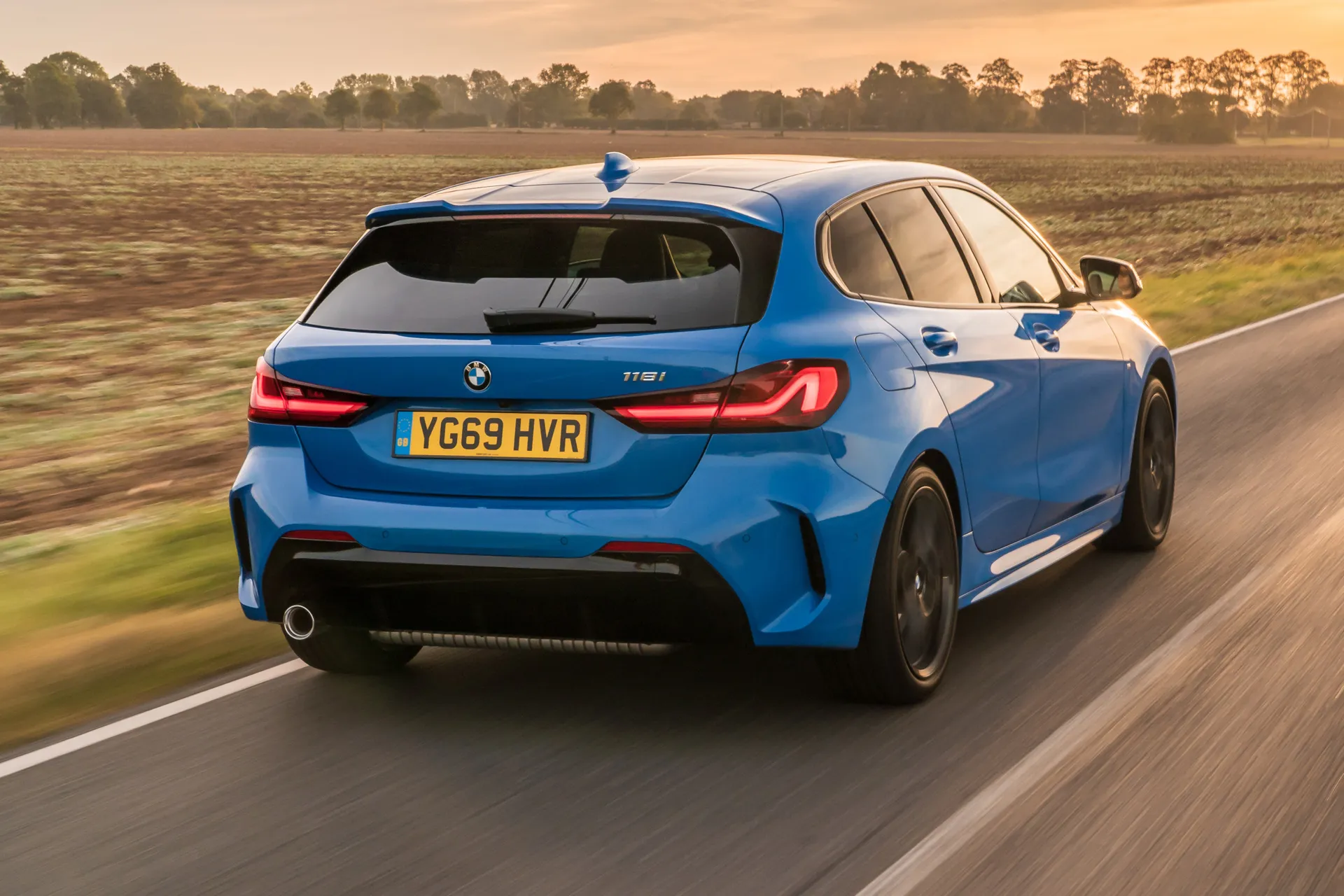
Stick with the manual gearbox and both the 116d and 118d should get close to 60mpg during gentle motorway cruising, while the 120d xDrive - unsurprisingly - the thirstiest diesel, returning up to 53.3mpg in fuel economy tests.
Hopefully, you won’t be surprised to read the M135i is quite a thirsty choice, officially capable of up to 35.8mpg. That’ll be considerably lower if you make the most of its performance. The BMW 128ti, meanwhile, is capable of up to 40.9mpg combined , a considerable bump up from the four-wheel drive car. We managed over 35mpg, even when making full use the performance.
How reliable is the BMW 1 Series?
BMW generally has a decent reputation for reliability. BMW also came 12th out of 29 manufacturers in the latest HonestJohn.co.uk Satisfaction Index: four places ahead of Audi and eight ahead of Mercedes-Benz.
For the time being, there doesn't seem to be many common issues with the BMW 1 Series for now, with the car proving to be very reliable.
Insurance groups and costs
The cheapest BMW 1 Series to insure is the 116d, which falls into insurance group 16. There are no big surprises in the rest of the range - although it’s worth noting that the 120d ranks a number of insurance groups higher than the 118d. Of course, the costliest BMW 1 Series to insure is the BMW M135i.
These groups are all broadly in-line with competitor models like the Audi A3 and Mercedes-Benz A-Class. Of course, you’ll probably pay a little bit more to insure a BMW 1 Series than something like a Vauxhall Astra, but it shouldn’t cost a fortune unless you’re a young driver.
You might find our guide to the cheapest BMW models to insure if you're in the market for a new BMW.
VED car tax: What is the annual road tax on a BMW 1 Series?
The third-generation BMW 1 Series is taxed under the latest VED bands. That means, from the second payment onwards, you’ll pay a flat rate of £190 a year. The first owner will have covered the first CO2-based payment.
It’s worth watching out for the so-called premium car tax, which applies to any cars with a list price of more than £40,000 when brand new. It’s difficult to spend this much on a 1 Series but it is possible, particularly if you find an M135i or an lesser car loaded with options. As desirable as this is, it’ll cost an extra £390 a year in tax for its first five years. Even as the second owner, you’ll be responsible for this.
How much should you be paying for a used BMW 1 Series?
"The desirable BMW badge keeps used prices pretty punchy compared with mainstream rivals, but the 1 Series has been around long enough that there are some useful savings to be made on the used car market."
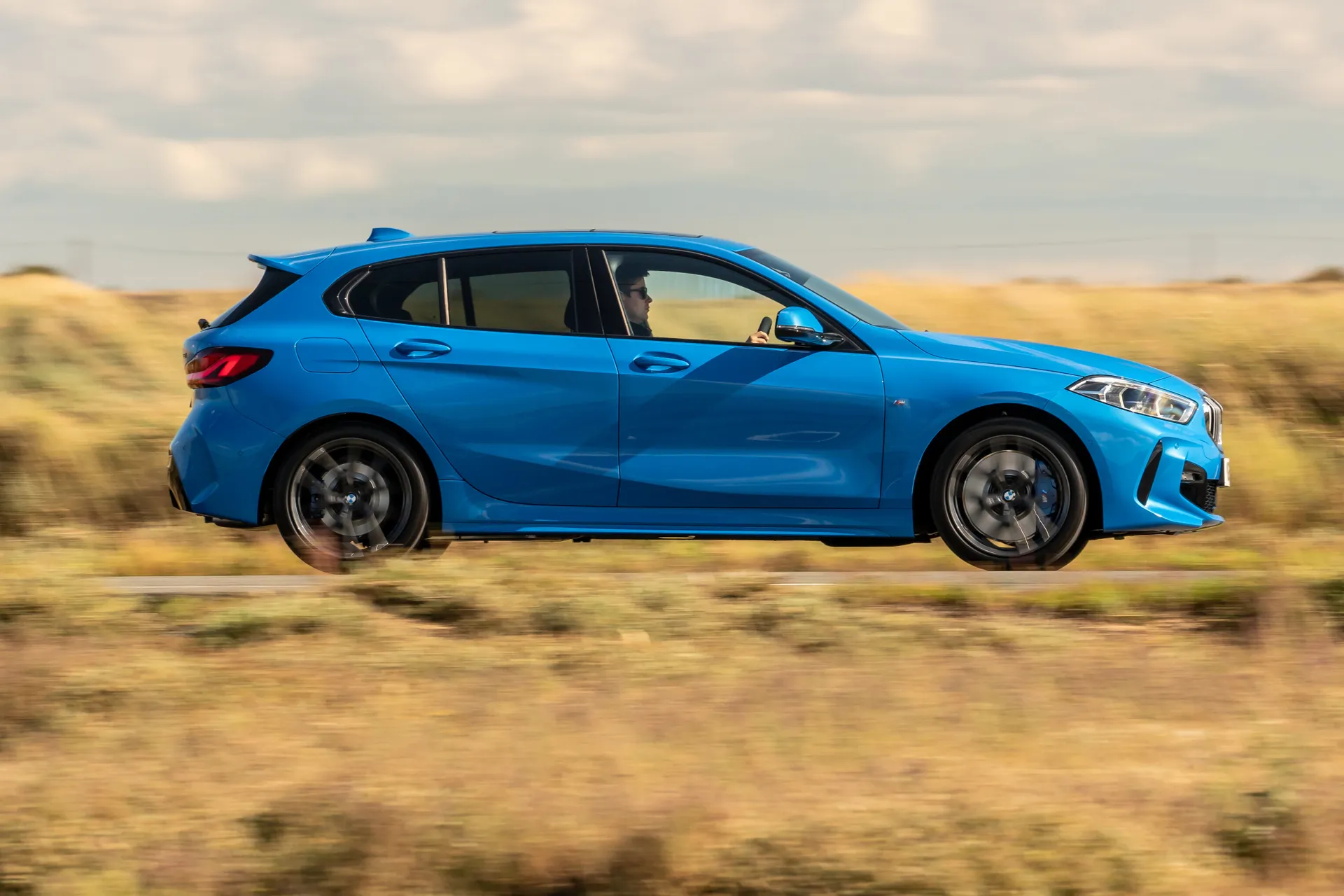
The cheapest examples of the current 1 Series in our listings stand at around £14,000. These are early 116d cars in SE trim with upwards of 70,000 miles on the clock. However, you don't have to spend a lot more - we're talking less than £1,000 - to get hold of a 118i of a similar age with around half the miles under its wheels. A smidge more cash will upgrade you to the desirable Sport trim.
If you want something a bit newer, you're looking at around £24,000 for a year-old 118i in M Sport trim with a four-figure mileage. If you're after more performance, three-year-old 128ti versions start at around £24,000, while a three-year-old M135i can be had for only a smidge more.
Trim levels and standard equipment
The entry-level BMW 1 Series wears an SE badge, with standard kit including 16-inch alloy wheels, automatic air con, Bluetooth, cruise control, LED headlights, front and rear parking sensors, rain sensor with automatic headlights and a three-spoke leather-covered steering wheel. Early models will have the 8.8-inch infotainment screen, but this was later upgraded to a 10.25-inch system across the range.
Most buyers will want to hunt out the BMW 1 Series Sport model for its 17-inch wheels, two-zone air conditioning, various nice interior touches (such as contrast stitching, faux-leather upholstery and door sill finishers), front sport seats and sporty exterior highlights.
The popular BMW 1 Series M Sport model adds 18-inch alloy wheels, automatic headlights, Dakota leather seats, M aerodynamic body styling, firmer M Sport suspension and heated front sport seats.
The range-topping BMW 1 Series M135i xDrive builds on M Sport models with bespoke 18-inch alloy wheels, the bigger 10.25-inch Live Cockpit Professional Infotainment system and various M aerodynamic bodystyling upgrades.
Ask the heycar experts: common questions
Is the BMW 1 Series a good car?
Can I buy a three-door BMW 1 Series?
What is the best BMW 1 Series engine?
Get our latest advice, news and offers
Keep me updated by email with the latest advice, news and offers from heycar.
By submitting you agree to our privacy policy
